Analysis of External Reporting Practices of Corporate
VerifiedAdded on 2023/03/31
|20
|3841
|243
AI Summary
This report analyzes the external reporting practices of corporate, including the history and development of the conceptual framework for financial reporting. It also discusses the application of the conceptual framework by REA Limited and the integrated reporting framework.
Contribute Materials
Your contribution can guide someone’s learning journey. Share your
documents today.
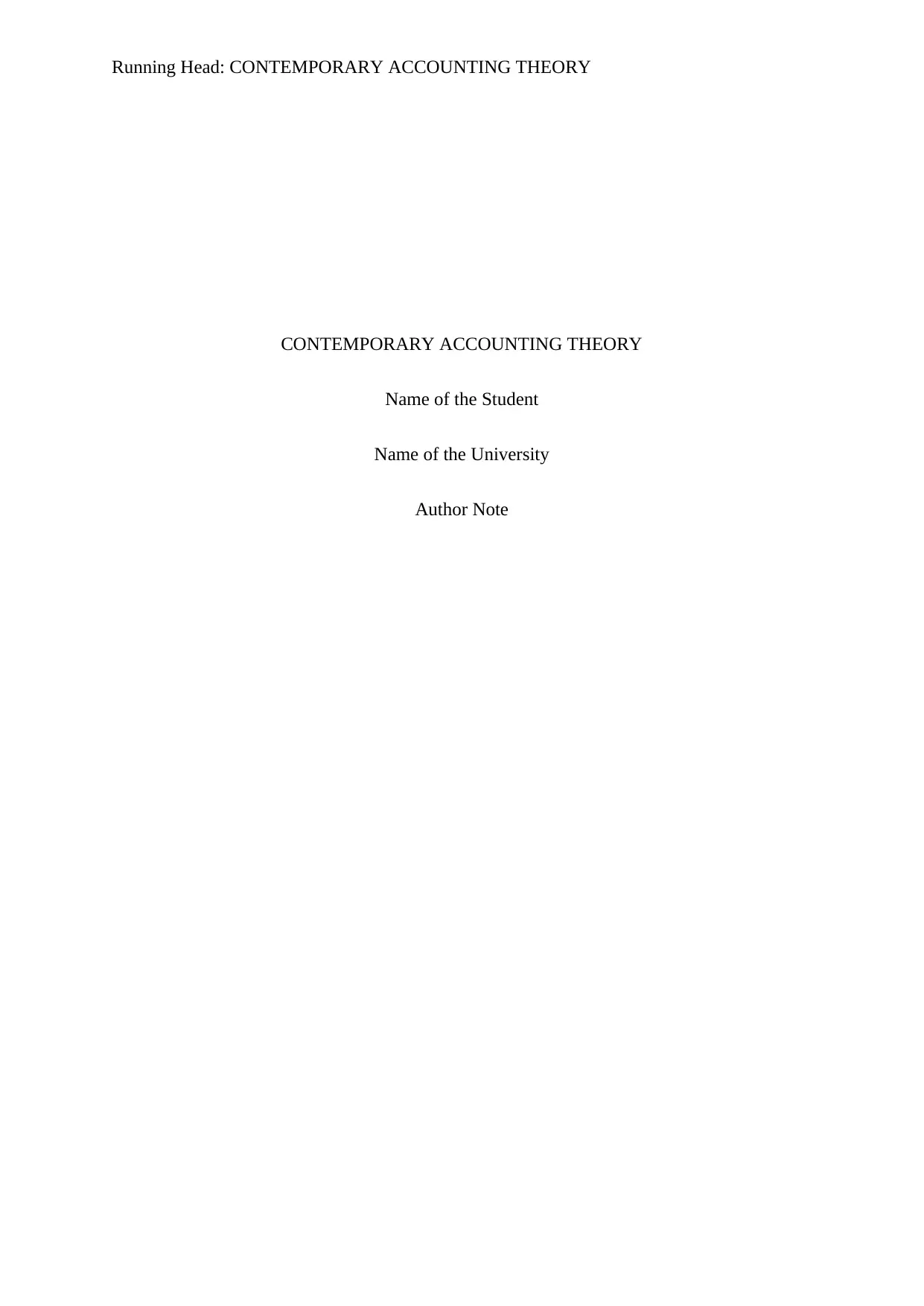
Running Head: CONTEMPORARY ACCOUNTING THEORY
CONTEMPORARY ACCOUNTING THEORY
Name of the Student
Name of the University
Author Note
CONTEMPORARY ACCOUNTING THEORY
Name of the Student
Name of the University
Author Note
Secure Best Marks with AI Grader
Need help grading? Try our AI Grader for instant feedback on your assignments.
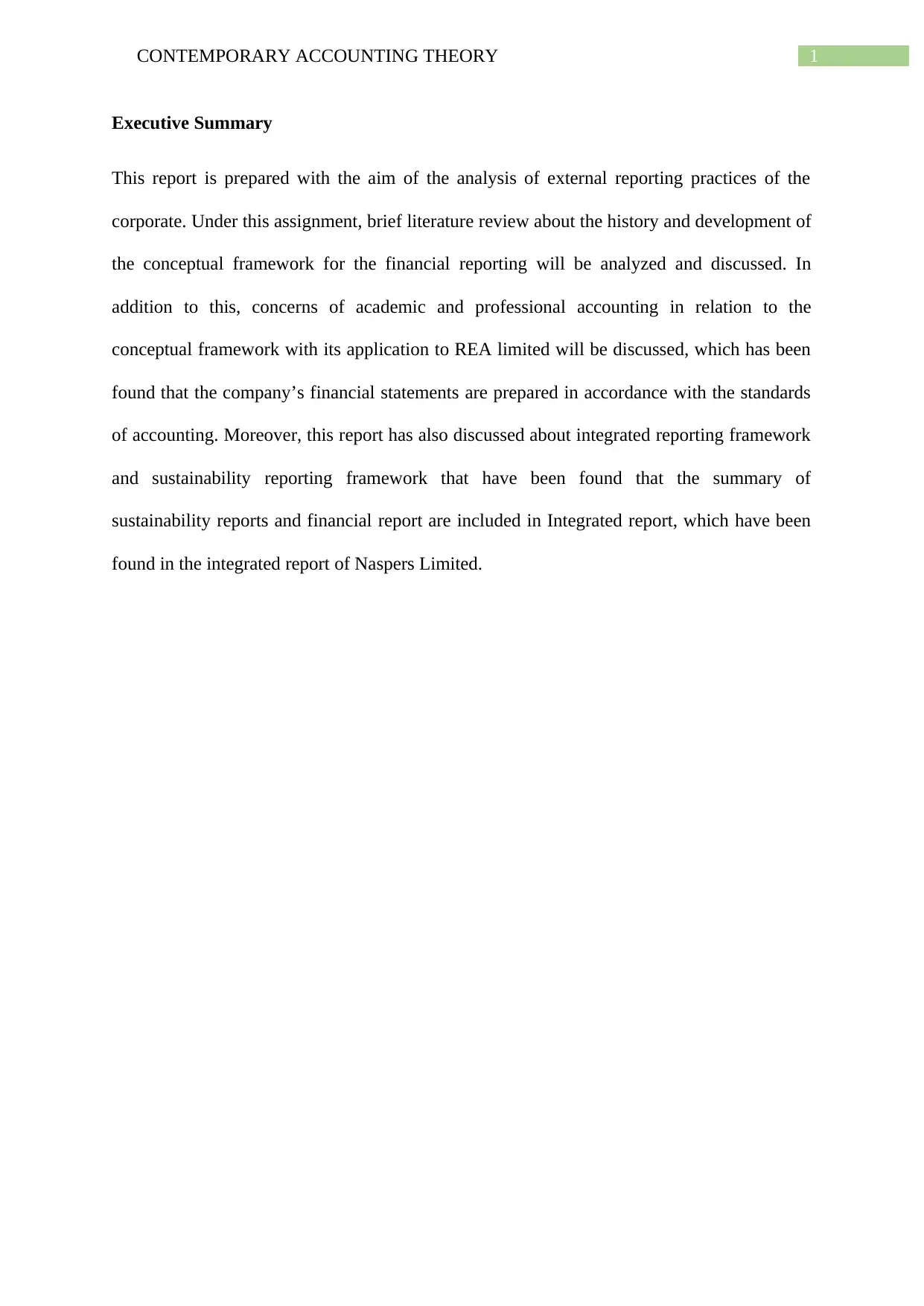
1CONTEMPORARY ACCOUNTING THEORY
Executive Summary
This report is prepared with the aim of the analysis of external reporting practices of the
corporate. Under this assignment, brief literature review about the history and development of
the conceptual framework for the financial reporting will be analyzed and discussed. In
addition to this, concerns of academic and professional accounting in relation to the
conceptual framework with its application to REA limited will be discussed, which has been
found that the company’s financial statements are prepared in accordance with the standards
of accounting. Moreover, this report has also discussed about integrated reporting framework
and sustainability reporting framework that have been found that the summary of
sustainability reports and financial report are included in Integrated report, which have been
found in the integrated report of Naspers Limited.
Executive Summary
This report is prepared with the aim of the analysis of external reporting practices of the
corporate. Under this assignment, brief literature review about the history and development of
the conceptual framework for the financial reporting will be analyzed and discussed. In
addition to this, concerns of academic and professional accounting in relation to the
conceptual framework with its application to REA limited will be discussed, which has been
found that the company’s financial statements are prepared in accordance with the standards
of accounting. Moreover, this report has also discussed about integrated reporting framework
and sustainability reporting framework that have been found that the summary of
sustainability reports and financial report are included in Integrated report, which have been
found in the integrated report of Naspers Limited.
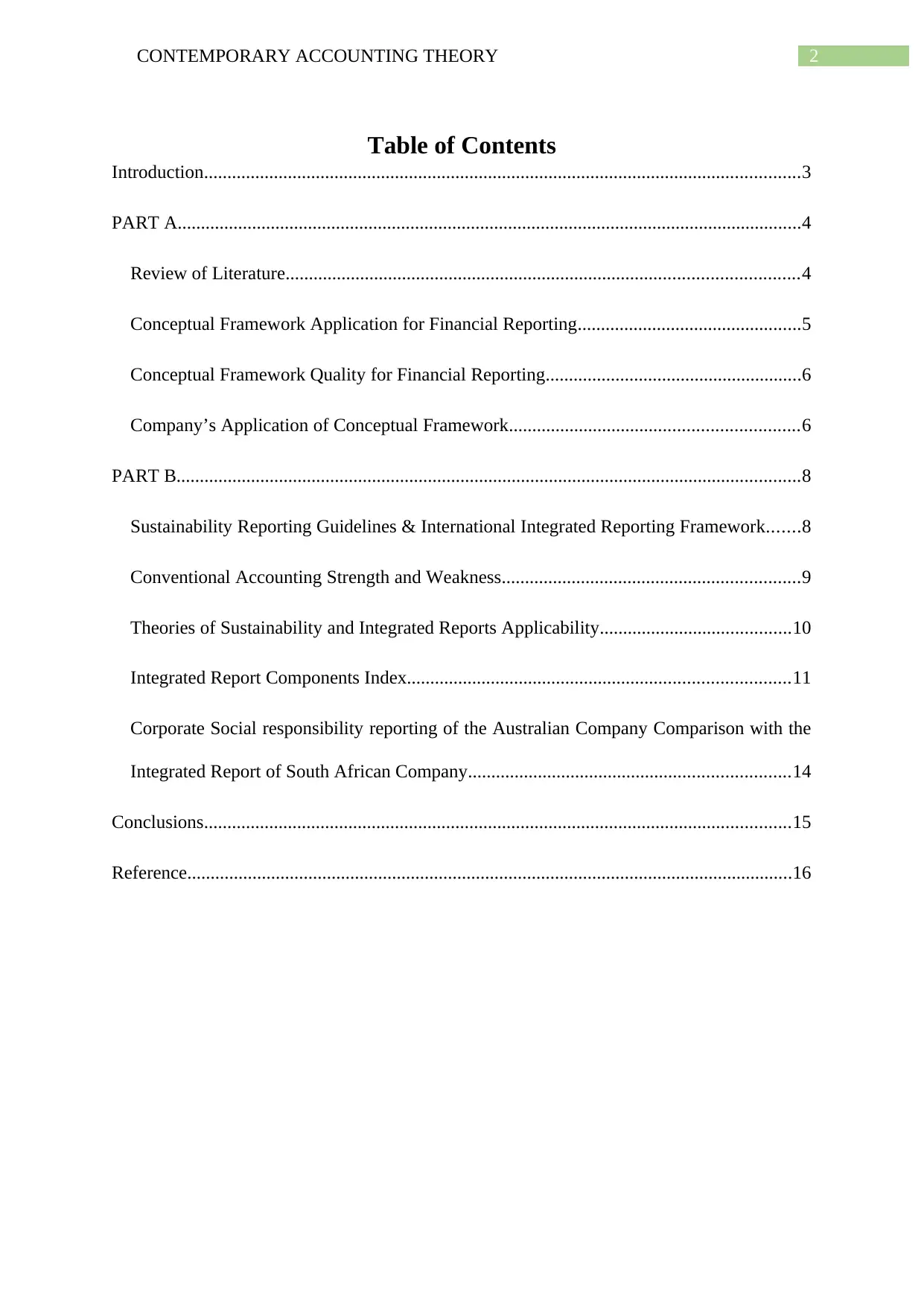
2CONTEMPORARY ACCOUNTING THEORY
Table of Contents
Introduction................................................................................................................................3
PART A......................................................................................................................................4
Review of Literature..............................................................................................................4
Conceptual Framework Application for Financial Reporting................................................5
Conceptual Framework Quality for Financial Reporting.......................................................6
Company’s Application of Conceptual Framework..............................................................6
PART B......................................................................................................................................8
Sustainability Reporting Guidelines & International Integrated Reporting Framework.......8
Conventional Accounting Strength and Weakness................................................................9
Theories of Sustainability and Integrated Reports Applicability.........................................10
Integrated Report Components Index..................................................................................11
Corporate Social responsibility reporting of the Australian Company Comparison with the
Integrated Report of South African Company.....................................................................14
Conclusions..............................................................................................................................15
Reference..................................................................................................................................16
Table of Contents
Introduction................................................................................................................................3
PART A......................................................................................................................................4
Review of Literature..............................................................................................................4
Conceptual Framework Application for Financial Reporting................................................5
Conceptual Framework Quality for Financial Reporting.......................................................6
Company’s Application of Conceptual Framework..............................................................6
PART B......................................................................................................................................8
Sustainability Reporting Guidelines & International Integrated Reporting Framework.......8
Conventional Accounting Strength and Weakness................................................................9
Theories of Sustainability and Integrated Reports Applicability.........................................10
Integrated Report Components Index..................................................................................11
Corporate Social responsibility reporting of the Australian Company Comparison with the
Integrated Report of South African Company.....................................................................14
Conclusions..............................................................................................................................15
Reference..................................................................................................................................16
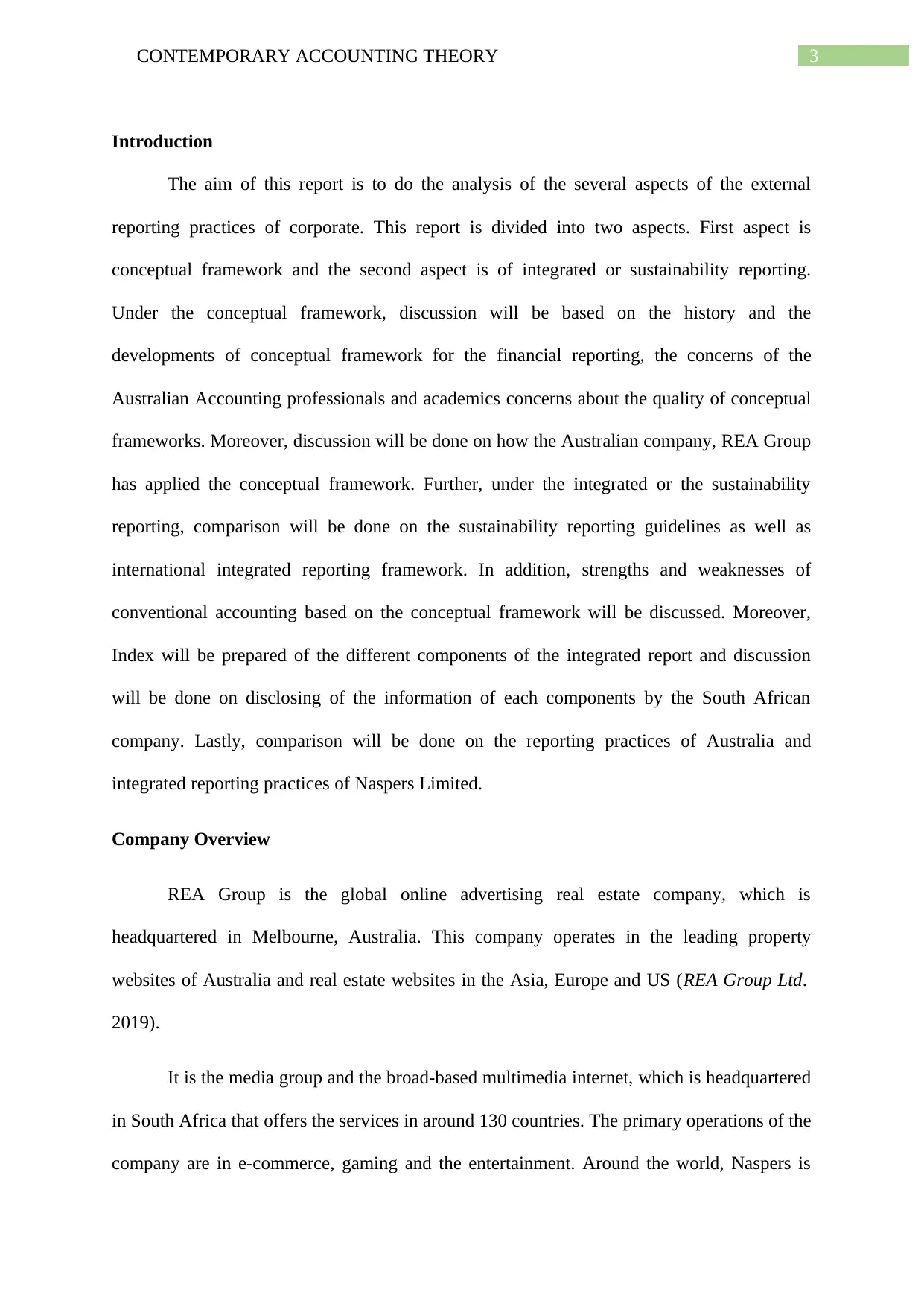
3CONTEMPORARY ACCOUNTING THEORY
Introduction
The aim of this report is to do the analysis of the several aspects of the external
reporting practices of corporate. This report is divided into two aspects. First aspect is
conceptual framework and the second aspect is of integrated or sustainability reporting.
Under the conceptual framework, discussion will be based on the history and the
developments of conceptual framework for the financial reporting, the concerns of the
Australian Accounting professionals and academics concerns about the quality of conceptual
frameworks. Moreover, discussion will be done on how the Australian company, REA Group
has applied the conceptual framework. Further, under the integrated or the sustainability
reporting, comparison will be done on the sustainability reporting guidelines as well as
international integrated reporting framework. In addition, strengths and weaknesses of
conventional accounting based on the conceptual framework will be discussed. Moreover,
Index will be prepared of the different components of the integrated report and discussion
will be done on disclosing of the information of each components by the South African
company. Lastly, comparison will be done on the reporting practices of Australia and
integrated reporting practices of Naspers Limited.
Company Overview
REA Group is the global online advertising real estate company, which is
headquartered in Melbourne, Australia. This company operates in the leading property
websites of Australia and real estate websites in the Asia, Europe and US (REA Group Ltd.
2019).
It is the media group and the broad-based multimedia internet, which is headquartered
in South Africa that offers the services in around 130 countries. The primary operations of the
company are in e-commerce, gaming and the entertainment. Around the world, Naspers is
Introduction
The aim of this report is to do the analysis of the several aspects of the external
reporting practices of corporate. This report is divided into two aspects. First aspect is
conceptual framework and the second aspect is of integrated or sustainability reporting.
Under the conceptual framework, discussion will be based on the history and the
developments of conceptual framework for the financial reporting, the concerns of the
Australian Accounting professionals and academics concerns about the quality of conceptual
frameworks. Moreover, discussion will be done on how the Australian company, REA Group
has applied the conceptual framework. Further, under the integrated or the sustainability
reporting, comparison will be done on the sustainability reporting guidelines as well as
international integrated reporting framework. In addition, strengths and weaknesses of
conventional accounting based on the conceptual framework will be discussed. Moreover,
Index will be prepared of the different components of the integrated report and discussion
will be done on disclosing of the information of each components by the South African
company. Lastly, comparison will be done on the reporting practices of Australia and
integrated reporting practices of Naspers Limited.
Company Overview
REA Group is the global online advertising real estate company, which is
headquartered in Melbourne, Australia. This company operates in the leading property
websites of Australia and real estate websites in the Asia, Europe and US (REA Group Ltd.
2019).
It is the media group and the broad-based multimedia internet, which is headquartered
in South Africa that offers the services in around 130 countries. The primary operations of the
company are in e-commerce, gaming and the entertainment. Around the world, Naspers is
Secure Best Marks with AI Grader
Need help grading? Try our AI Grader for instant feedback on your assignments.
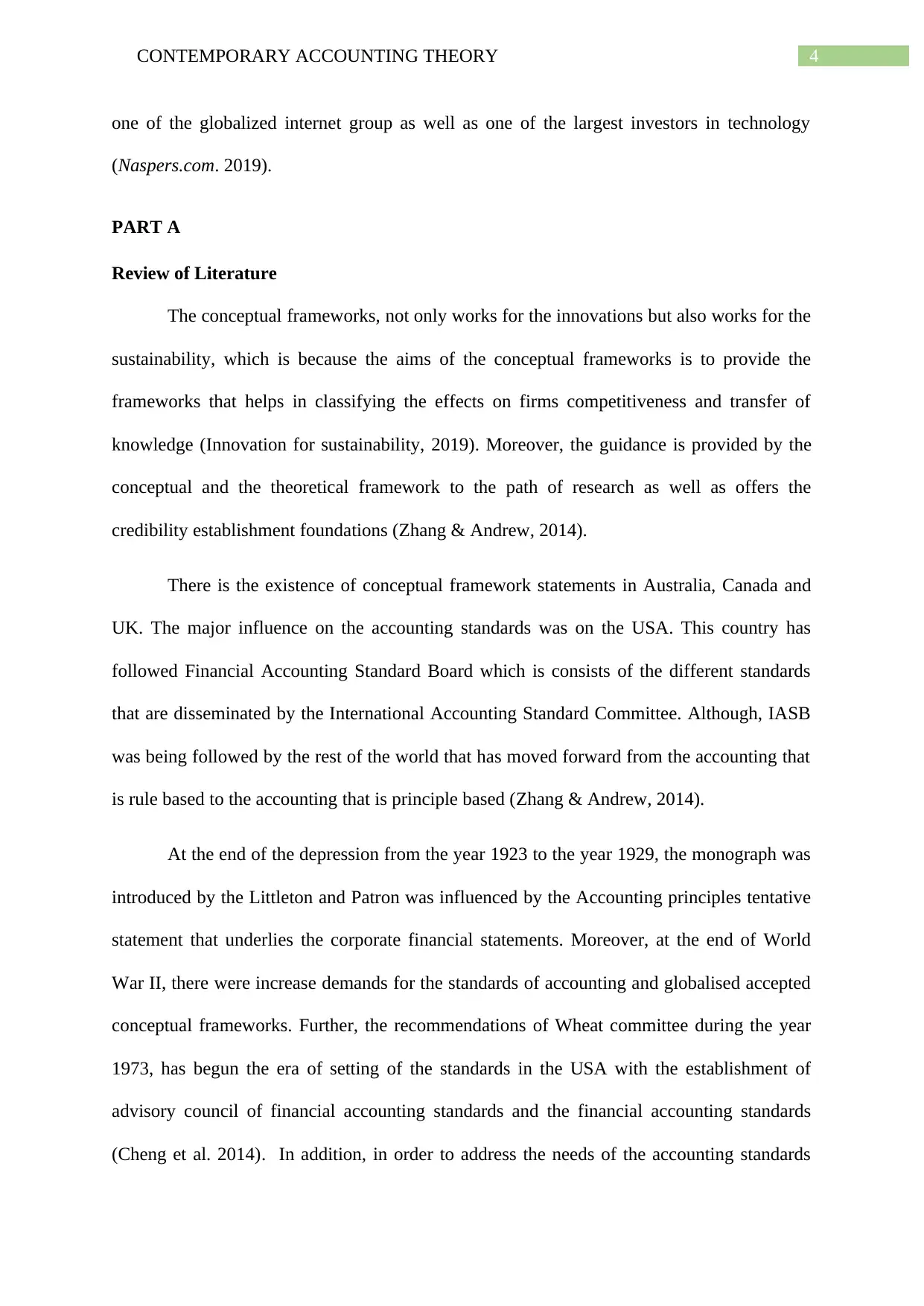
4CONTEMPORARY ACCOUNTING THEORY
one of the globalized internet group as well as one of the largest investors in technology
(Naspers.com. 2019).
PART A
Review of Literature
The conceptual frameworks, not only works for the innovations but also works for the
sustainability, which is because the aims of the conceptual frameworks is to provide the
frameworks that helps in classifying the effects on firms competitiveness and transfer of
knowledge (Innovation for sustainability, 2019). Moreover, the guidance is provided by the
conceptual and the theoretical framework to the path of research as well as offers the
credibility establishment foundations (Zhang & Andrew, 2014).
There is the existence of conceptual framework statements in Australia, Canada and
UK. The major influence on the accounting standards was on the USA. This country has
followed Financial Accounting Standard Board which is consists of the different standards
that are disseminated by the International Accounting Standard Committee. Although, IASB
was being followed by the rest of the world that has moved forward from the accounting that
is rule based to the accounting that is principle based (Zhang & Andrew, 2014).
At the end of the depression from the year 1923 to the year 1929, the monograph was
introduced by the Littleton and Patron was influenced by the Accounting principles tentative
statement that underlies the corporate financial statements. Moreover, at the end of World
War II, there were increase demands for the standards of accounting and globalised accepted
conceptual frameworks. Further, the recommendations of Wheat committee during the year
1973, has begun the era of setting of the standards in the USA with the establishment of
advisory council of financial accounting standards and the financial accounting standards
(Cheng et al. 2014). In addition, in order to address the needs of the accounting standards
one of the globalized internet group as well as one of the largest investors in technology
(Naspers.com. 2019).
PART A
Review of Literature
The conceptual frameworks, not only works for the innovations but also works for the
sustainability, which is because the aims of the conceptual frameworks is to provide the
frameworks that helps in classifying the effects on firms competitiveness and transfer of
knowledge (Innovation for sustainability, 2019). Moreover, the guidance is provided by the
conceptual and the theoretical framework to the path of research as well as offers the
credibility establishment foundations (Zhang & Andrew, 2014).
There is the existence of conceptual framework statements in Australia, Canada and
UK. The major influence on the accounting standards was on the USA. This country has
followed Financial Accounting Standard Board which is consists of the different standards
that are disseminated by the International Accounting Standard Committee. Although, IASB
was being followed by the rest of the world that has moved forward from the accounting that
is rule based to the accounting that is principle based (Zhang & Andrew, 2014).
At the end of the depression from the year 1923 to the year 1929, the monograph was
introduced by the Littleton and Patron was influenced by the Accounting principles tentative
statement that underlies the corporate financial statements. Moreover, at the end of World
War II, there were increase demands for the standards of accounting and globalised accepted
conceptual frameworks. Further, the recommendations of Wheat committee during the year
1973, has begun the era of setting of the standards in the USA with the establishment of
advisory council of financial accounting standards and the financial accounting standards
(Cheng et al. 2014). In addition, in order to address the needs of the accounting standards
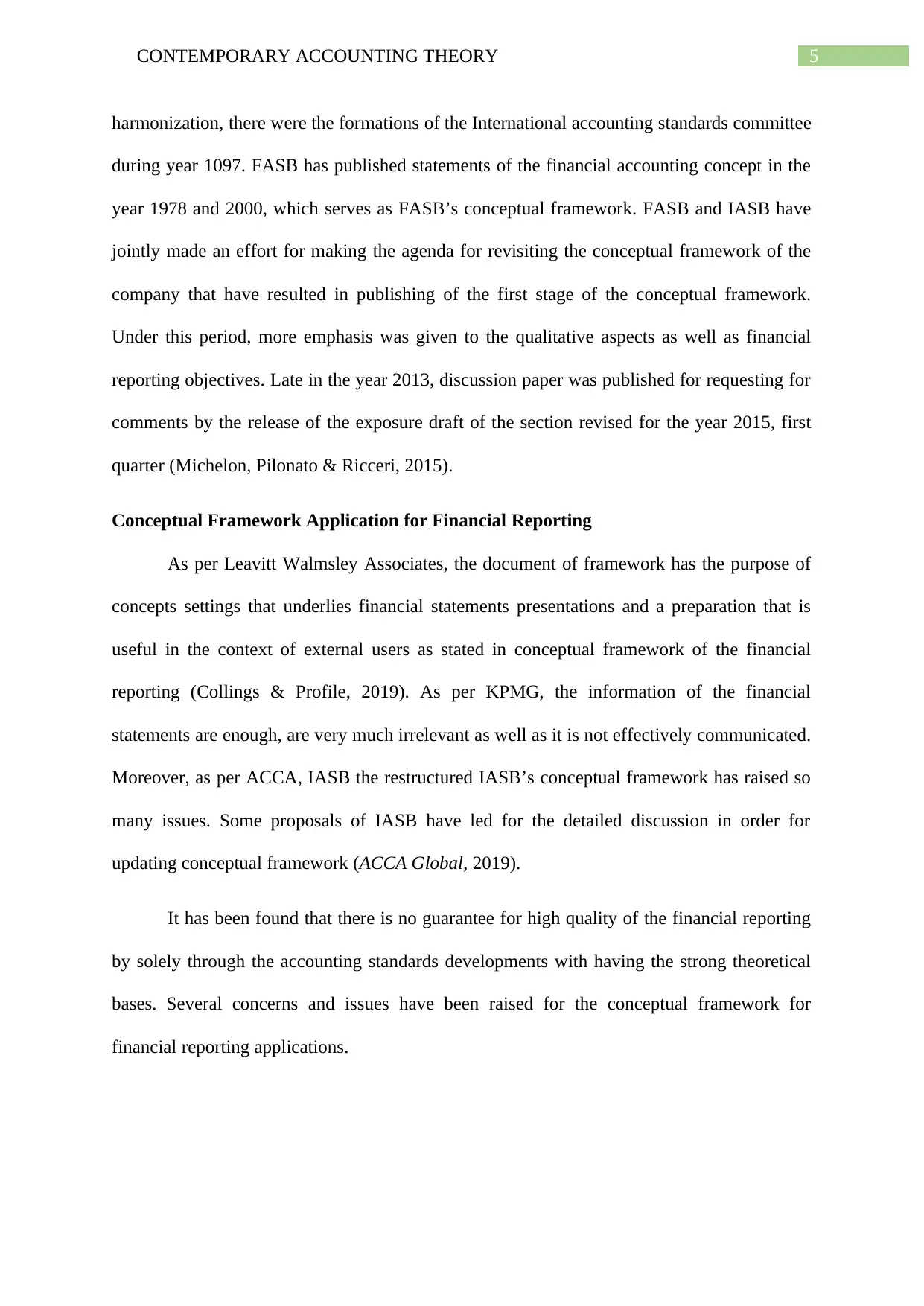
5CONTEMPORARY ACCOUNTING THEORY
harmonization, there were the formations of the International accounting standards committee
during year 1097. FASB has published statements of the financial accounting concept in the
year 1978 and 2000, which serves as FASB’s conceptual framework. FASB and IASB have
jointly made an effort for making the agenda for revisiting the conceptual framework of the
company that have resulted in publishing of the first stage of the conceptual framework.
Under this period, more emphasis was given to the qualitative aspects as well as financial
reporting objectives. Late in the year 2013, discussion paper was published for requesting for
comments by the release of the exposure draft of the section revised for the year 2015, first
quarter (Michelon, Pilonato & Ricceri, 2015).
Conceptual Framework Application for Financial Reporting
As per Leavitt Walmsley Associates, the document of framework has the purpose of
concepts settings that underlies financial statements presentations and a preparation that is
useful in the context of external users as stated in conceptual framework of the financial
reporting (Collings & Profile, 2019). As per KPMG, the information of the financial
statements are enough, are very much irrelevant as well as it is not effectively communicated.
Moreover, as per ACCA, IASB the restructured IASB’s conceptual framework has raised so
many issues. Some proposals of IASB have led for the detailed discussion in order for
updating conceptual framework (ACCA Global, 2019).
It has been found that there is no guarantee for high quality of the financial reporting
by solely through the accounting standards developments with having the strong theoretical
bases. Several concerns and issues have been raised for the conceptual framework for
financial reporting applications.
harmonization, there were the formations of the International accounting standards committee
during year 1097. FASB has published statements of the financial accounting concept in the
year 1978 and 2000, which serves as FASB’s conceptual framework. FASB and IASB have
jointly made an effort for making the agenda for revisiting the conceptual framework of the
company that have resulted in publishing of the first stage of the conceptual framework.
Under this period, more emphasis was given to the qualitative aspects as well as financial
reporting objectives. Late in the year 2013, discussion paper was published for requesting for
comments by the release of the exposure draft of the section revised for the year 2015, first
quarter (Michelon, Pilonato & Ricceri, 2015).
Conceptual Framework Application for Financial Reporting
As per Leavitt Walmsley Associates, the document of framework has the purpose of
concepts settings that underlies financial statements presentations and a preparation that is
useful in the context of external users as stated in conceptual framework of the financial
reporting (Collings & Profile, 2019). As per KPMG, the information of the financial
statements are enough, are very much irrelevant as well as it is not effectively communicated.
Moreover, as per ACCA, IASB the restructured IASB’s conceptual framework has raised so
many issues. Some proposals of IASB have led for the detailed discussion in order for
updating conceptual framework (ACCA Global, 2019).
It has been found that there is no guarantee for high quality of the financial reporting
by solely through the accounting standards developments with having the strong theoretical
bases. Several concerns and issues have been raised for the conceptual framework for
financial reporting applications.
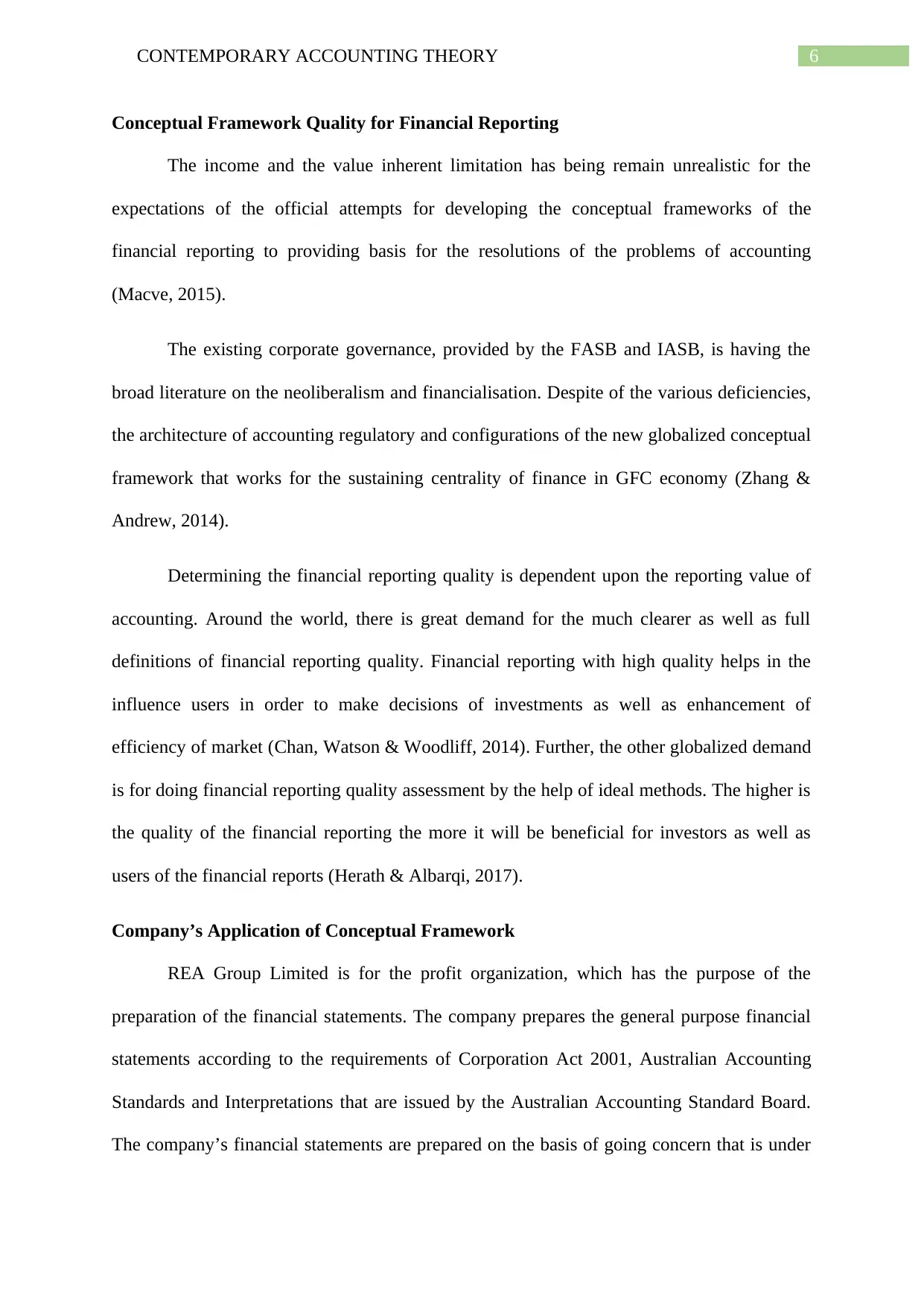
6CONTEMPORARY ACCOUNTING THEORY
Conceptual Framework Quality for Financial Reporting
The income and the value inherent limitation has being remain unrealistic for the
expectations of the official attempts for developing the conceptual frameworks of the
financial reporting to providing basis for the resolutions of the problems of accounting
(Macve, 2015).
The existing corporate governance, provided by the FASB and IASB, is having the
broad literature on the neoliberalism and financialisation. Despite of the various deficiencies,
the architecture of accounting regulatory and configurations of the new globalized conceptual
framework that works for the sustaining centrality of finance in GFC economy (Zhang &
Andrew, 2014).
Determining the financial reporting quality is dependent upon the reporting value of
accounting. Around the world, there is great demand for the much clearer as well as full
definitions of financial reporting quality. Financial reporting with high quality helps in the
influence users in order to make decisions of investments as well as enhancement of
efficiency of market (Chan, Watson & Woodliff, 2014). Further, the other globalized demand
is for doing financial reporting quality assessment by the help of ideal methods. The higher is
the quality of the financial reporting the more it will be beneficial for investors as well as
users of the financial reports (Herath & Albarqi, 2017).
Company’s Application of Conceptual Framework
REA Group Limited is for the profit organization, which has the purpose of the
preparation of the financial statements. The company prepares the general purpose financial
statements according to the requirements of Corporation Act 2001, Australian Accounting
Standards and Interpretations that are issued by the Australian Accounting Standard Board.
The company’s financial statements are prepared on the basis of going concern that is under
Conceptual Framework Quality for Financial Reporting
The income and the value inherent limitation has being remain unrealistic for the
expectations of the official attempts for developing the conceptual frameworks of the
financial reporting to providing basis for the resolutions of the problems of accounting
(Macve, 2015).
The existing corporate governance, provided by the FASB and IASB, is having the
broad literature on the neoliberalism and financialisation. Despite of the various deficiencies,
the architecture of accounting regulatory and configurations of the new globalized conceptual
framework that works for the sustaining centrality of finance in GFC economy (Zhang &
Andrew, 2014).
Determining the financial reporting quality is dependent upon the reporting value of
accounting. Around the world, there is great demand for the much clearer as well as full
definitions of financial reporting quality. Financial reporting with high quality helps in the
influence users in order to make decisions of investments as well as enhancement of
efficiency of market (Chan, Watson & Woodliff, 2014). Further, the other globalized demand
is for doing financial reporting quality assessment by the help of ideal methods. The higher is
the quality of the financial reporting the more it will be beneficial for investors as well as
users of the financial reports (Herath & Albarqi, 2017).
Company’s Application of Conceptual Framework
REA Group Limited is for the profit organization, which has the purpose of the
preparation of the financial statements. The company prepares the general purpose financial
statements according to the requirements of Corporation Act 2001, Australian Accounting
Standards and Interpretations that are issued by the Australian Accounting Standard Board.
The company’s financial statements are prepared on the basis of going concern that is under
Paraphrase This Document
Need a fresh take? Get an instant paraphrase of this document with our AI Paraphraser
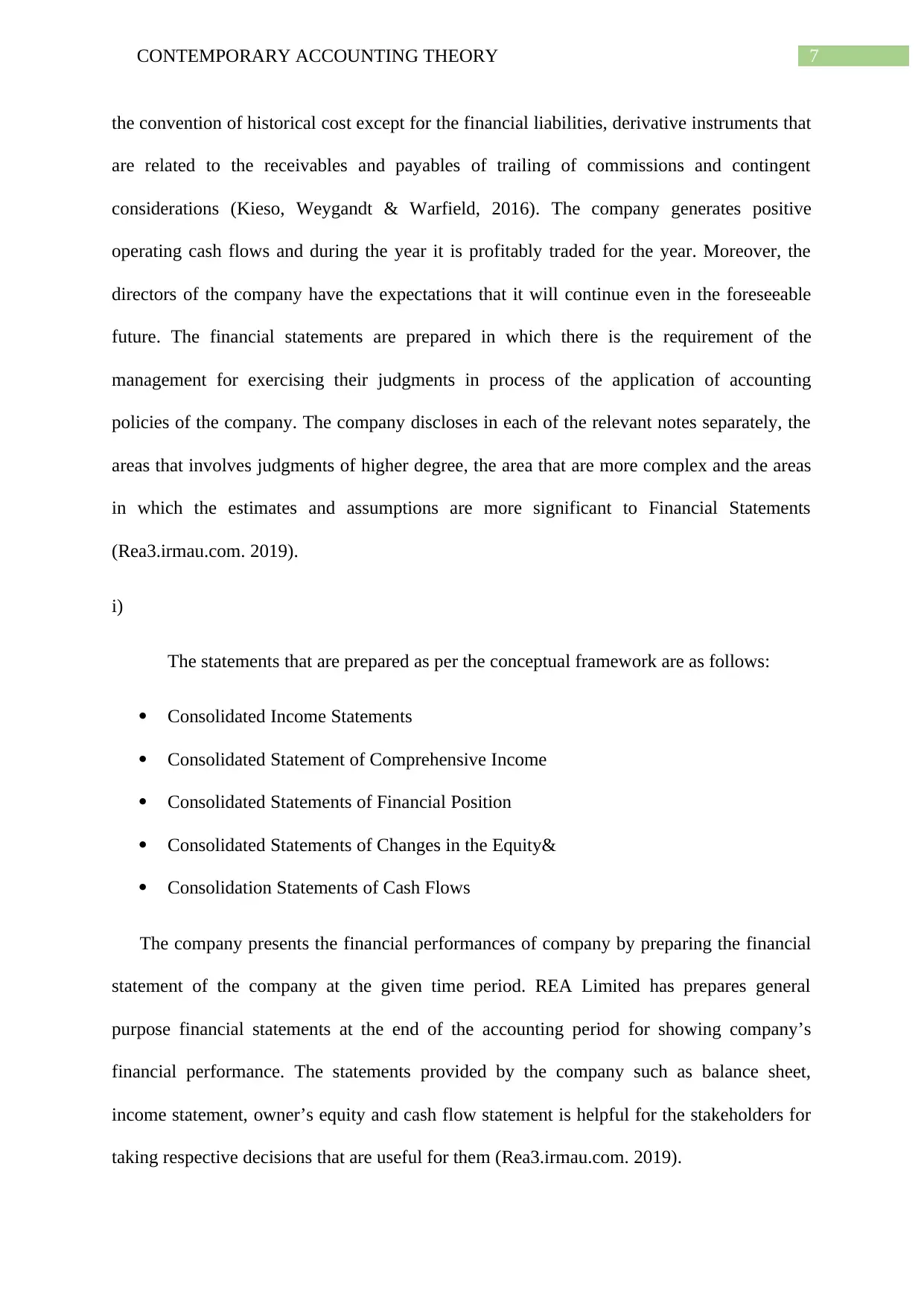
7CONTEMPORARY ACCOUNTING THEORY
the convention of historical cost except for the financial liabilities, derivative instruments that
are related to the receivables and payables of trailing of commissions and contingent
considerations (Kieso, Weygandt & Warfield, 2016). The company generates positive
operating cash flows and during the year it is profitably traded for the year. Moreover, the
directors of the company have the expectations that it will continue even in the foreseeable
future. The financial statements are prepared in which there is the requirement of the
management for exercising their judgments in process of the application of accounting
policies of the company. The company discloses in each of the relevant notes separately, the
areas that involves judgments of higher degree, the area that are more complex and the areas
in which the estimates and assumptions are more significant to Financial Statements
(Rea3.irmau.com. 2019).
i)
The statements that are prepared as per the conceptual framework are as follows:
Consolidated Income Statements
Consolidated Statement of Comprehensive Income
Consolidated Statements of Financial Position
Consolidated Statements of Changes in the Equity&
Consolidation Statements of Cash Flows
The company presents the financial performances of company by preparing the financial
statement of the company at the given time period. REA Limited has prepares general
purpose financial statements at the end of the accounting period for showing company’s
financial performance. The statements provided by the company such as balance sheet,
income statement, owner’s equity and cash flow statement is helpful for the stakeholders for
taking respective decisions that are useful for them (Rea3.irmau.com. 2019).
the convention of historical cost except for the financial liabilities, derivative instruments that
are related to the receivables and payables of trailing of commissions and contingent
considerations (Kieso, Weygandt & Warfield, 2016). The company generates positive
operating cash flows and during the year it is profitably traded for the year. Moreover, the
directors of the company have the expectations that it will continue even in the foreseeable
future. The financial statements are prepared in which there is the requirement of the
management for exercising their judgments in process of the application of accounting
policies of the company. The company discloses in each of the relevant notes separately, the
areas that involves judgments of higher degree, the area that are more complex and the areas
in which the estimates and assumptions are more significant to Financial Statements
(Rea3.irmau.com. 2019).
i)
The statements that are prepared as per the conceptual framework are as follows:
Consolidated Income Statements
Consolidated Statement of Comprehensive Income
Consolidated Statements of Financial Position
Consolidated Statements of Changes in the Equity&
Consolidation Statements of Cash Flows
The company presents the financial performances of company by preparing the financial
statement of the company at the given time period. REA Limited has prepares general
purpose financial statements at the end of the accounting period for showing company’s
financial performance. The statements provided by the company such as balance sheet,
income statement, owner’s equity and cash flow statement is helpful for the stakeholders for
taking respective decisions that are useful for them (Rea3.irmau.com. 2019).
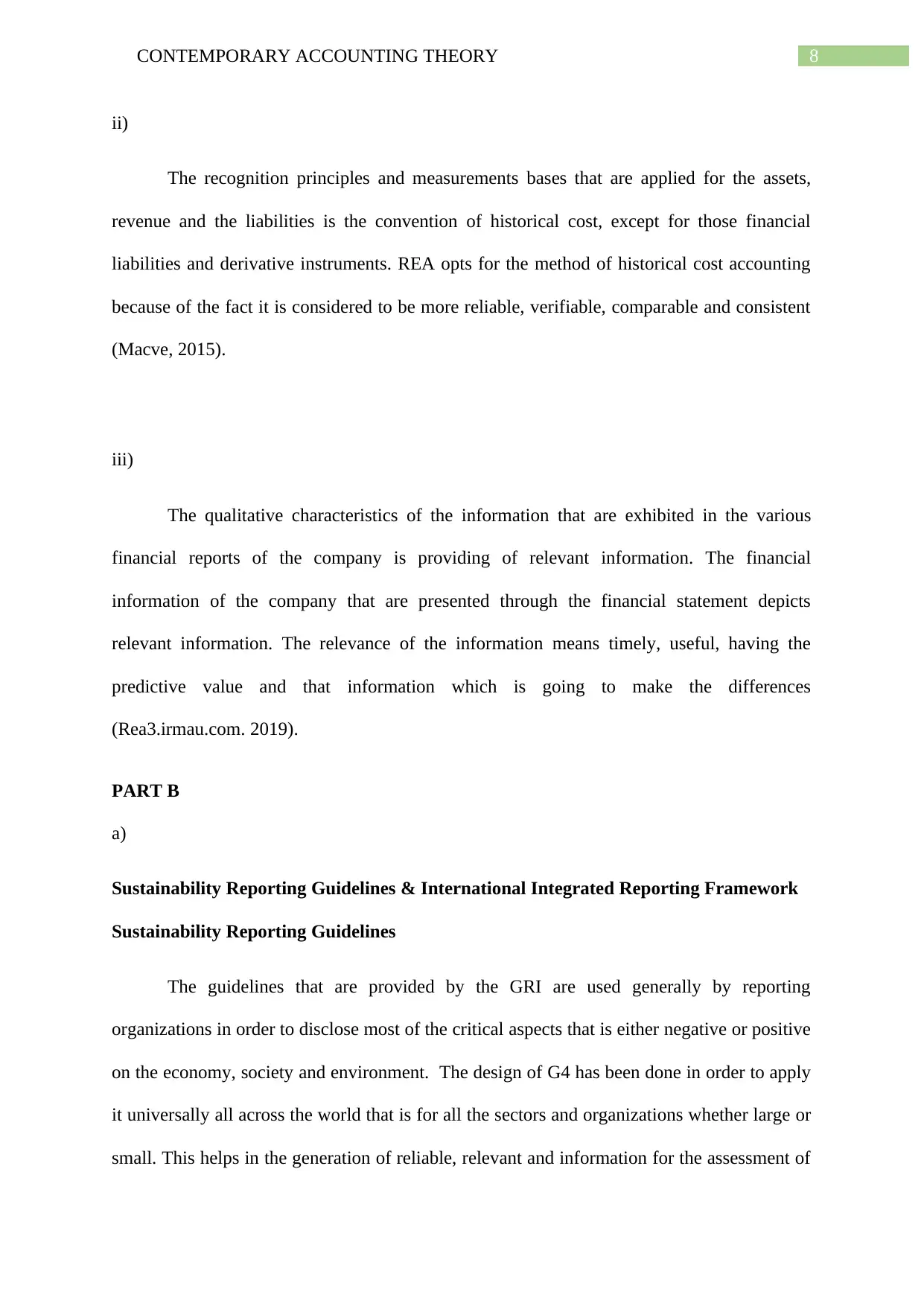
8CONTEMPORARY ACCOUNTING THEORY
ii)
The recognition principles and measurements bases that are applied for the assets,
revenue and the liabilities is the convention of historical cost, except for those financial
liabilities and derivative instruments. REA opts for the method of historical cost accounting
because of the fact it is considered to be more reliable, verifiable, comparable and consistent
(Macve, 2015).
iii)
The qualitative characteristics of the information that are exhibited in the various
financial reports of the company is providing of relevant information. The financial
information of the company that are presented through the financial statement depicts
relevant information. The relevance of the information means timely, useful, having the
predictive value and that information which is going to make the differences
(Rea3.irmau.com. 2019).
PART B
a)
Sustainability Reporting Guidelines & International Integrated Reporting Framework
Sustainability Reporting Guidelines
The guidelines that are provided by the GRI are used generally by reporting
organizations in order to disclose most of the critical aspects that is either negative or positive
on the economy, society and environment. The design of G4 has been done in order to apply
it universally all across the world that is for all the sectors and organizations whether large or
small. This helps in the generation of reliable, relevant and information for the assessment of
ii)
The recognition principles and measurements bases that are applied for the assets,
revenue and the liabilities is the convention of historical cost, except for those financial
liabilities and derivative instruments. REA opts for the method of historical cost accounting
because of the fact it is considered to be more reliable, verifiable, comparable and consistent
(Macve, 2015).
iii)
The qualitative characteristics of the information that are exhibited in the various
financial reports of the company is providing of relevant information. The financial
information of the company that are presented through the financial statement depicts
relevant information. The relevance of the information means timely, useful, having the
predictive value and that information which is going to make the differences
(Rea3.irmau.com. 2019).
PART B
a)
Sustainability Reporting Guidelines & International Integrated Reporting Framework
Sustainability Reporting Guidelines
The guidelines that are provided by the GRI are used generally by reporting
organizations in order to disclose most of the critical aspects that is either negative or positive
on the economy, society and environment. The design of G4 has been done in order to apply
it universally all across the world that is for all the sectors and organizations whether large or
small. This helps in the generation of reliable, relevant and information for the assessment of
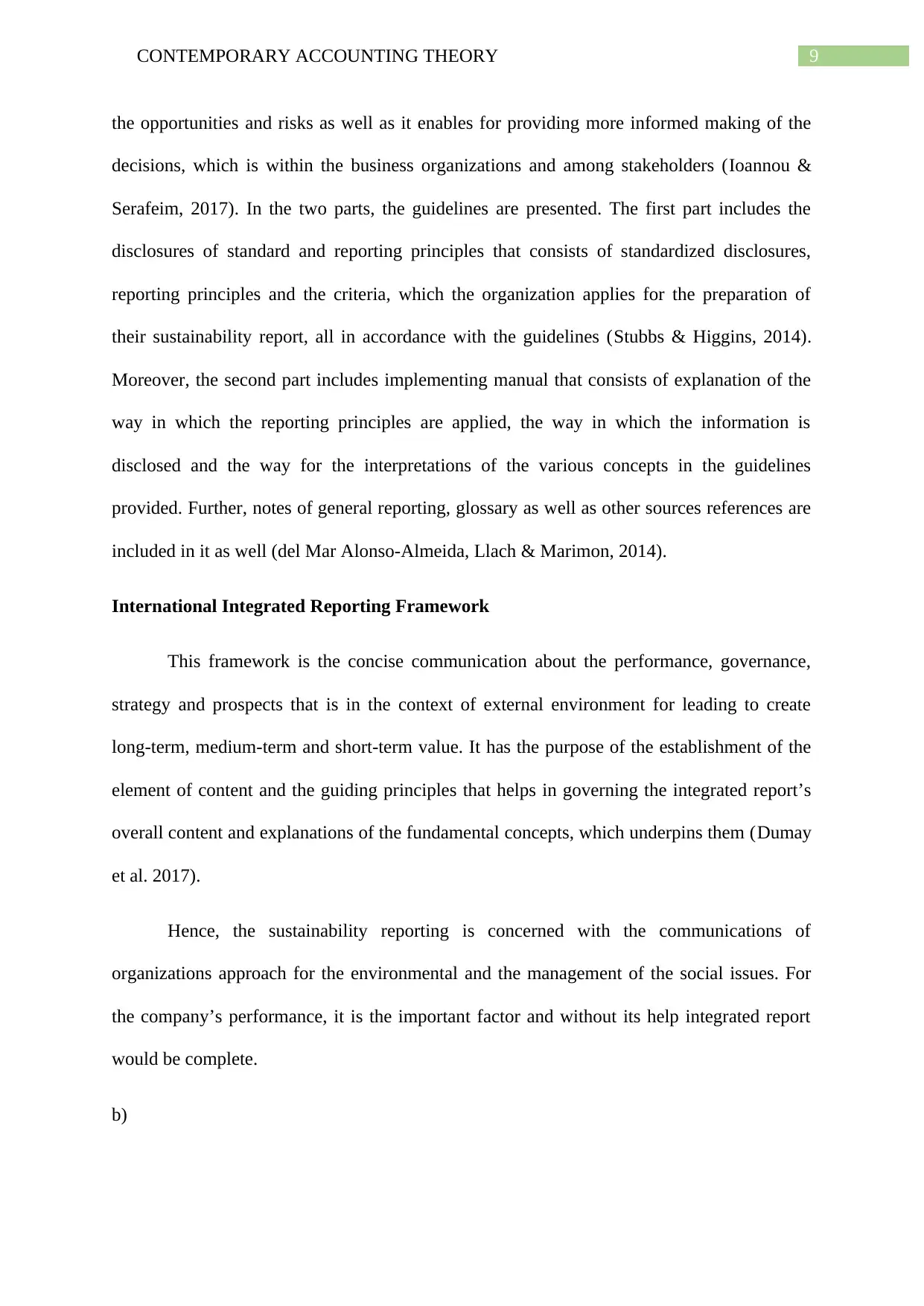
9CONTEMPORARY ACCOUNTING THEORY
the opportunities and risks as well as it enables for providing more informed making of the
decisions, which is within the business organizations and among stakeholders (Ioannou &
Serafeim, 2017). In the two parts, the guidelines are presented. The first part includes the
disclosures of standard and reporting principles that consists of standardized disclosures,
reporting principles and the criteria, which the organization applies for the preparation of
their sustainability report, all in accordance with the guidelines (Stubbs & Higgins, 2014).
Moreover, the second part includes implementing manual that consists of explanation of the
way in which the reporting principles are applied, the way in which the information is
disclosed and the way for the interpretations of the various concepts in the guidelines
provided. Further, notes of general reporting, glossary as well as other sources references are
included in it as well (del Mar Alonso‐Almeida, Llach & Marimon, 2014).
International Integrated Reporting Framework
This framework is the concise communication about the performance, governance,
strategy and prospects that is in the context of external environment for leading to create
long-term, medium-term and short-term value. It has the purpose of the establishment of the
element of content and the guiding principles that helps in governing the integrated report’s
overall content and explanations of the fundamental concepts, which underpins them (Dumay
et al. 2017).
Hence, the sustainability reporting is concerned with the communications of
organizations approach for the environmental and the management of the social issues. For
the company’s performance, it is the important factor and without its help integrated report
would be complete.
b)
the opportunities and risks as well as it enables for providing more informed making of the
decisions, which is within the business organizations and among stakeholders (Ioannou &
Serafeim, 2017). In the two parts, the guidelines are presented. The first part includes the
disclosures of standard and reporting principles that consists of standardized disclosures,
reporting principles and the criteria, which the organization applies for the preparation of
their sustainability report, all in accordance with the guidelines (Stubbs & Higgins, 2014).
Moreover, the second part includes implementing manual that consists of explanation of the
way in which the reporting principles are applied, the way in which the information is
disclosed and the way for the interpretations of the various concepts in the guidelines
provided. Further, notes of general reporting, glossary as well as other sources references are
included in it as well (del Mar Alonso‐Almeida, Llach & Marimon, 2014).
International Integrated Reporting Framework
This framework is the concise communication about the performance, governance,
strategy and prospects that is in the context of external environment for leading to create
long-term, medium-term and short-term value. It has the purpose of the establishment of the
element of content and the guiding principles that helps in governing the integrated report’s
overall content and explanations of the fundamental concepts, which underpins them (Dumay
et al. 2017).
Hence, the sustainability reporting is concerned with the communications of
organizations approach for the environmental and the management of the social issues. For
the company’s performance, it is the important factor and without its help integrated report
would be complete.
b)
Secure Best Marks with AI Grader
Need help grading? Try our AI Grader for instant feedback on your assignments.
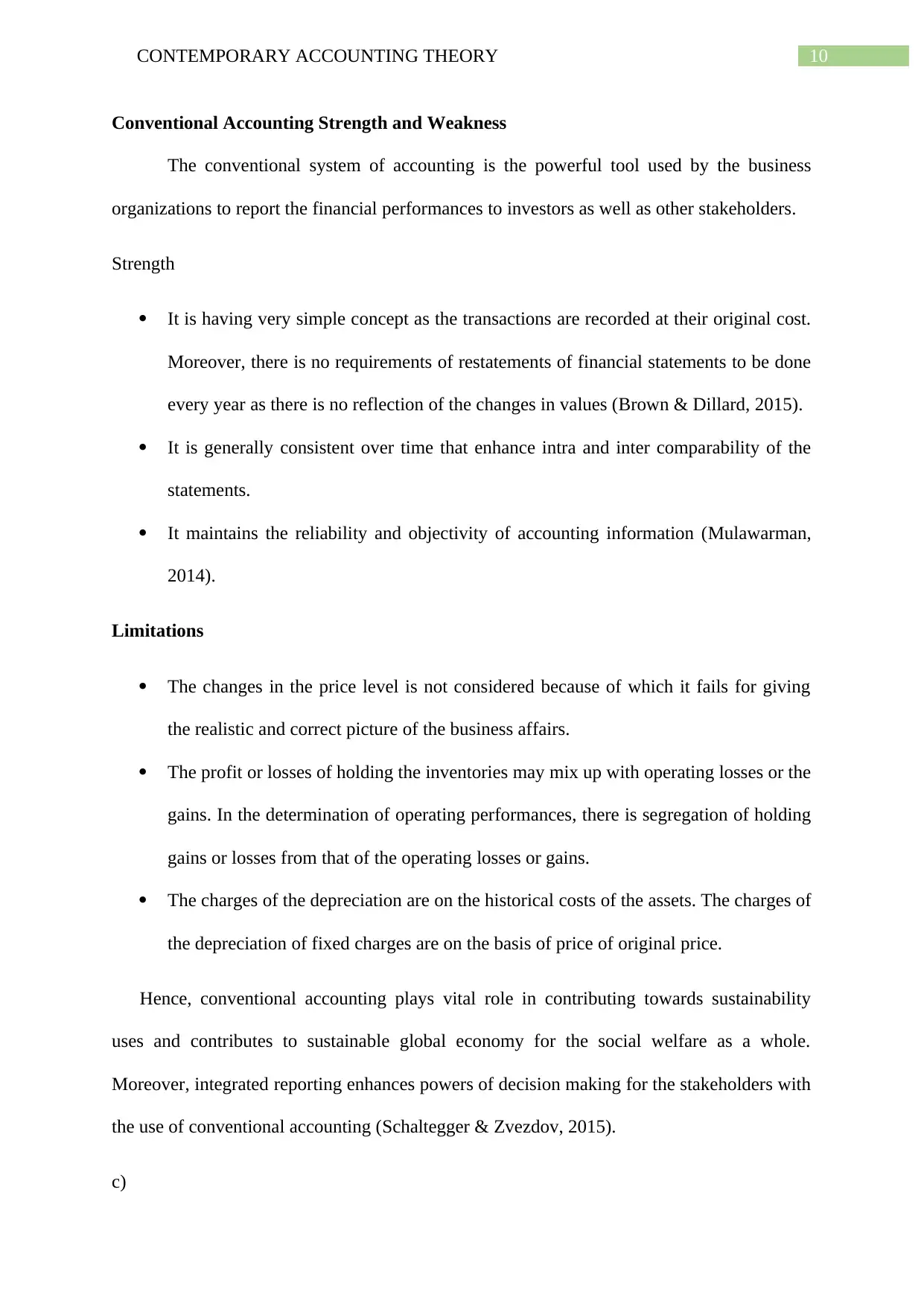
10CONTEMPORARY ACCOUNTING THEORY
Conventional Accounting Strength and Weakness
The conventional system of accounting is the powerful tool used by the business
organizations to report the financial performances to investors as well as other stakeholders.
Strength
It is having very simple concept as the transactions are recorded at their original cost.
Moreover, there is no requirements of restatements of financial statements to be done
every year as there is no reflection of the changes in values (Brown & Dillard, 2015).
It is generally consistent over time that enhance intra and inter comparability of the
statements.
It maintains the reliability and objectivity of accounting information (Mulawarman,
2014).
Limitations
The changes in the price level is not considered because of which it fails for giving
the realistic and correct picture of the business affairs.
The profit or losses of holding the inventories may mix up with operating losses or the
gains. In the determination of operating performances, there is segregation of holding
gains or losses from that of the operating losses or gains.
The charges of the depreciation are on the historical costs of the assets. The charges of
the depreciation of fixed charges are on the basis of price of original price.
Hence, conventional accounting plays vital role in contributing towards sustainability
uses and contributes to sustainable global economy for the social welfare as a whole.
Moreover, integrated reporting enhances powers of decision making for the stakeholders with
the use of conventional accounting (Schaltegger & Zvezdov, 2015).
c)
Conventional Accounting Strength and Weakness
The conventional system of accounting is the powerful tool used by the business
organizations to report the financial performances to investors as well as other stakeholders.
Strength
It is having very simple concept as the transactions are recorded at their original cost.
Moreover, there is no requirements of restatements of financial statements to be done
every year as there is no reflection of the changes in values (Brown & Dillard, 2015).
It is generally consistent over time that enhance intra and inter comparability of the
statements.
It maintains the reliability and objectivity of accounting information (Mulawarman,
2014).
Limitations
The changes in the price level is not considered because of which it fails for giving
the realistic and correct picture of the business affairs.
The profit or losses of holding the inventories may mix up with operating losses or the
gains. In the determination of operating performances, there is segregation of holding
gains or losses from that of the operating losses or gains.
The charges of the depreciation are on the historical costs of the assets. The charges of
the depreciation of fixed charges are on the basis of price of original price.
Hence, conventional accounting plays vital role in contributing towards sustainability
uses and contributes to sustainable global economy for the social welfare as a whole.
Moreover, integrated reporting enhances powers of decision making for the stakeholders with
the use of conventional accounting (Schaltegger & Zvezdov, 2015).
c)
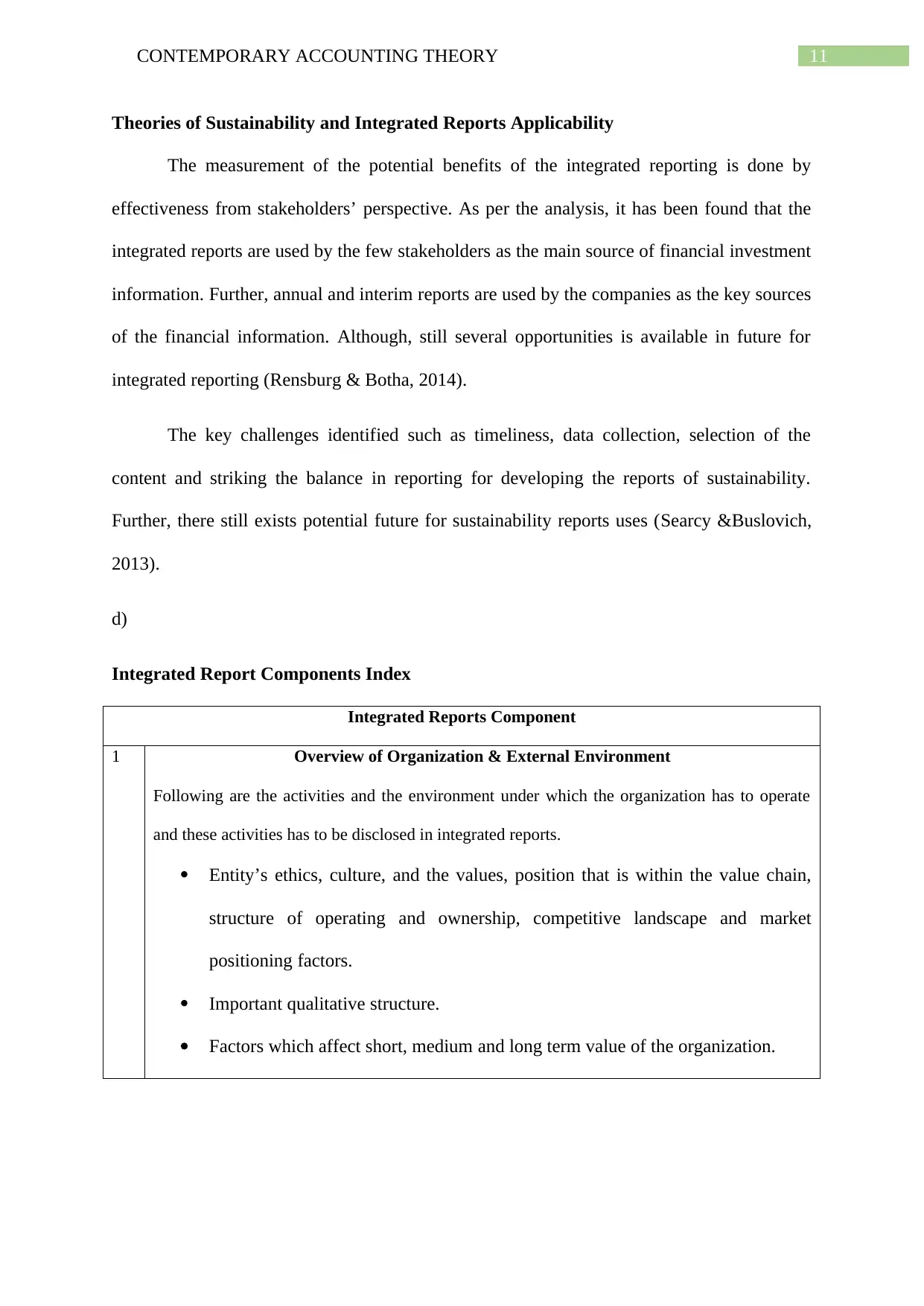
11CONTEMPORARY ACCOUNTING THEORY
Theories of Sustainability and Integrated Reports Applicability
The measurement of the potential benefits of the integrated reporting is done by
effectiveness from stakeholders’ perspective. As per the analysis, it has been found that the
integrated reports are used by the few stakeholders as the main source of financial investment
information. Further, annual and interim reports are used by the companies as the key sources
of the financial information. Although, still several opportunities is available in future for
integrated reporting (Rensburg & Botha, 2014).
The key challenges identified such as timeliness, data collection, selection of the
content and striking the balance in reporting for developing the reports of sustainability.
Further, there still exists potential future for sustainability reports uses (Searcy &Buslovich,
2013).
d)
Integrated Report Components Index
Integrated Reports Component
1 Overview of Organization & External Environment
Following are the activities and the environment under which the organization has to operate
and these activities has to be disclosed in integrated reports.
Entity’s ethics, culture, and the values, position that is within the value chain,
structure of operating and ownership, competitive landscape and market
positioning factors.
Important qualitative structure.
Factors which affect short, medium and long term value of the organization.
Theories of Sustainability and Integrated Reports Applicability
The measurement of the potential benefits of the integrated reporting is done by
effectiveness from stakeholders’ perspective. As per the analysis, it has been found that the
integrated reports are used by the few stakeholders as the main source of financial investment
information. Further, annual and interim reports are used by the companies as the key sources
of the financial information. Although, still several opportunities is available in future for
integrated reporting (Rensburg & Botha, 2014).
The key challenges identified such as timeliness, data collection, selection of the
content and striking the balance in reporting for developing the reports of sustainability.
Further, there still exists potential future for sustainability reports uses (Searcy &Buslovich,
2013).
d)
Integrated Report Components Index
Integrated Reports Component
1 Overview of Organization & External Environment
Following are the activities and the environment under which the organization has to operate
and these activities has to be disclosed in integrated reports.
Entity’s ethics, culture, and the values, position that is within the value chain,
structure of operating and ownership, competitive landscape and market
positioning factors.
Important qualitative structure.
Factors which affect short, medium and long term value of the organization.

12CONTEMPORARY ACCOUNTING THEORY
2 Governance
Organization’s leadership structure which includes diversity and skills of those
charged with governance.
Ethical code of conduct
Management of Risk
Linking of incentives and remunerations with value creation.
3 Identification/Relationship with Stakeholders
Identifying the stakeholders
Stakeholders Engagement
Stakeholder’s material matters identification.
Impacts assessments, their implications and stakeholder’s outlook of company’s
business model.
4 Model of Business
Inputs
Outputs
Activities of Business
Outcomes
5 Performance Overview
Qualitative indicators for the opportunities, risks and targets.
Organizational effects on capital.
Links between the performance of past as well as present and between current
performances and outlook of the entity.
Disclosure of financial performance of the company.
6 Opportunities, Risks and Internal Control
Disclosure of Internal and external sources of the risks and opportunities.
2 Governance
Organization’s leadership structure which includes diversity and skills of those
charged with governance.
Ethical code of conduct
Management of Risk
Linking of incentives and remunerations with value creation.
3 Identification/Relationship with Stakeholders
Identifying the stakeholders
Stakeholders Engagement
Stakeholder’s material matters identification.
Impacts assessments, their implications and stakeholder’s outlook of company’s
business model.
4 Model of Business
Inputs
Outputs
Activities of Business
Outcomes
5 Performance Overview
Qualitative indicators for the opportunities, risks and targets.
Organizational effects on capital.
Links between the performance of past as well as present and between current
performances and outlook of the entity.
Disclosure of financial performance of the company.
6 Opportunities, Risks and Internal Control
Disclosure of Internal and external sources of the risks and opportunities.
Paraphrase This Document
Need a fresh take? Get an instant paraphrase of this document with our AI Paraphraser
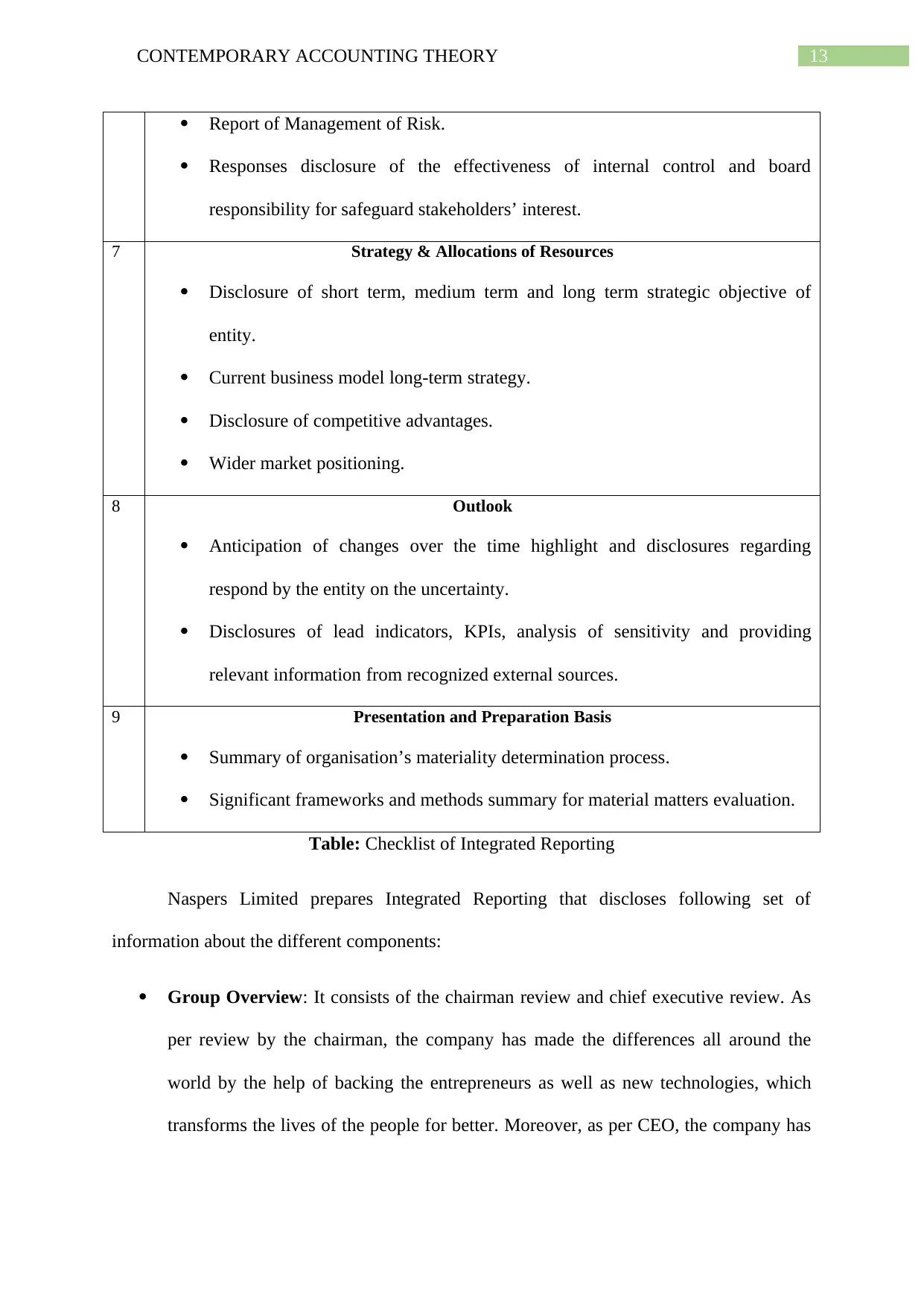
13CONTEMPORARY ACCOUNTING THEORY
Report of Management of Risk.
Responses disclosure of the effectiveness of internal control and board
responsibility for safeguard stakeholders’ interest.
7 Strategy & Allocations of Resources
Disclosure of short term, medium term and long term strategic objective of
entity.
Current business model long-term strategy.
Disclosure of competitive advantages.
Wider market positioning.
8 Outlook
Anticipation of changes over the time highlight and disclosures regarding
respond by the entity on the uncertainty.
Disclosures of lead indicators, KPIs, analysis of sensitivity and providing
relevant information from recognized external sources.
9 Presentation and Preparation Basis
Summary of organisation’s materiality determination process.
Significant frameworks and methods summary for material matters evaluation.
Table: Checklist of Integrated Reporting
Naspers Limited prepares Integrated Reporting that discloses following set of
information about the different components:
Group Overview: It consists of the chairman review and chief executive review. As
per review by the chairman, the company has made the differences all around the
world by the help of backing the entrepreneurs as well as new technologies, which
transforms the lives of the people for better. Moreover, as per CEO, the company has
Report of Management of Risk.
Responses disclosure of the effectiveness of internal control and board
responsibility for safeguard stakeholders’ interest.
7 Strategy & Allocations of Resources
Disclosure of short term, medium term and long term strategic objective of
entity.
Current business model long-term strategy.
Disclosure of competitive advantages.
Wider market positioning.
8 Outlook
Anticipation of changes over the time highlight and disclosures regarding
respond by the entity on the uncertainty.
Disclosures of lead indicators, KPIs, analysis of sensitivity and providing
relevant information from recognized external sources.
9 Presentation and Preparation Basis
Summary of organisation’s materiality determination process.
Significant frameworks and methods summary for material matters evaluation.
Table: Checklist of Integrated Reporting
Naspers Limited prepares Integrated Reporting that discloses following set of
information about the different components:
Group Overview: It consists of the chairman review and chief executive review. As
per review by the chairman, the company has made the differences all around the
world by the help of backing the entrepreneurs as well as new technologies, which
transforms the lives of the people for better. Moreover, as per CEO, the company has
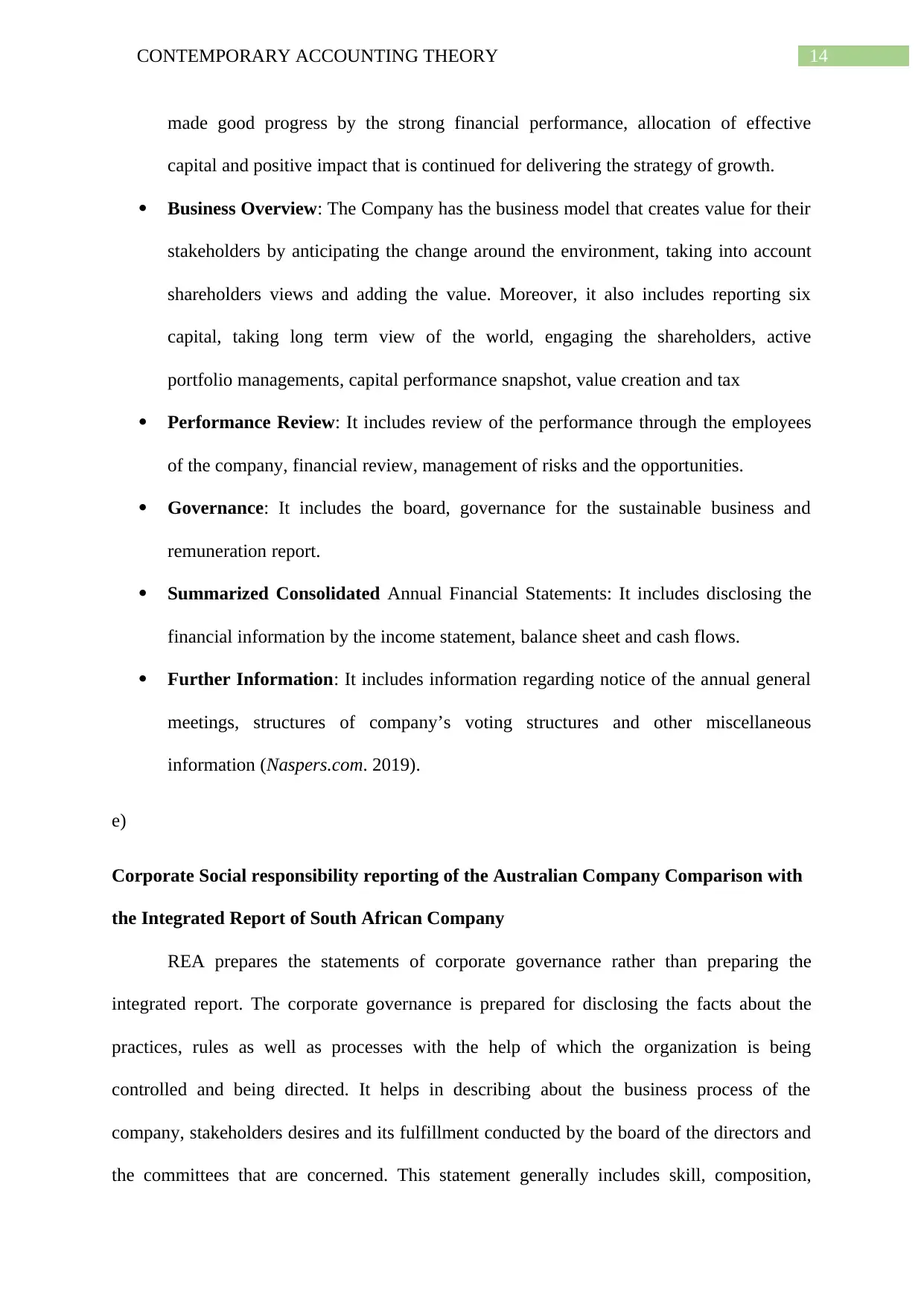
14CONTEMPORARY ACCOUNTING THEORY
made good progress by the strong financial performance, allocation of effective
capital and positive impact that is continued for delivering the strategy of growth.
Business Overview: The Company has the business model that creates value for their
stakeholders by anticipating the change around the environment, taking into account
shareholders views and adding the value. Moreover, it also includes reporting six
capital, taking long term view of the world, engaging the shareholders, active
portfolio managements, capital performance snapshot, value creation and tax
Performance Review: It includes review of the performance through the employees
of the company, financial review, management of risks and the opportunities.
Governance: It includes the board, governance for the sustainable business and
remuneration report.
Summarized Consolidated Annual Financial Statements: It includes disclosing the
financial information by the income statement, balance sheet and cash flows.
Further Information: It includes information regarding notice of the annual general
meetings, structures of company’s voting structures and other miscellaneous
information (Naspers.com. 2019).
e)
Corporate Social responsibility reporting of the Australian Company Comparison with
the Integrated Report of South African Company
REA prepares the statements of corporate governance rather than preparing the
integrated report. The corporate governance is prepared for disclosing the facts about the
practices, rules as well as processes with the help of which the organization is being
controlled and being directed. It helps in describing about the business process of the
company, stakeholders desires and its fulfillment conducted by the board of the directors and
the committees that are concerned. This statement generally includes skill, composition,
made good progress by the strong financial performance, allocation of effective
capital and positive impact that is continued for delivering the strategy of growth.
Business Overview: The Company has the business model that creates value for their
stakeholders by anticipating the change around the environment, taking into account
shareholders views and adding the value. Moreover, it also includes reporting six
capital, taking long term view of the world, engaging the shareholders, active
portfolio managements, capital performance snapshot, value creation and tax
Performance Review: It includes review of the performance through the employees
of the company, financial review, management of risks and the opportunities.
Governance: It includes the board, governance for the sustainable business and
remuneration report.
Summarized Consolidated Annual Financial Statements: It includes disclosing the
financial information by the income statement, balance sheet and cash flows.
Further Information: It includes information regarding notice of the annual general
meetings, structures of company’s voting structures and other miscellaneous
information (Naspers.com. 2019).
e)
Corporate Social responsibility reporting of the Australian Company Comparison with
the Integrated Report of South African Company
REA prepares the statements of corporate governance rather than preparing the
integrated report. The corporate governance is prepared for disclosing the facts about the
practices, rules as well as processes with the help of which the organization is being
controlled and being directed. It helps in describing about the business process of the
company, stakeholders desires and its fulfillment conducted by the board of the directors and
the committees that are concerned. This statement generally includes skill, composition,

15CONTEMPORARY ACCOUNTING THEORY
independence, remunerations, risk management, policies and sustainability of the company
and integrity of financial reporting. Further, company’s annual report is prepared for
disclosing about the financial performances at the end of particular time period (Fernandez-
Feijoo, Romero & Ruiz, 2014).
Therefore, all the summary of sustainability report and the annual report are contained
in the integrated reports as compare to disclosure by the company in two different reports as
it takes more efforts and more cost (Thomson, 2015).
independence, remunerations, risk management, policies and sustainability of the company
and integrity of financial reporting. Further, company’s annual report is prepared for
disclosing about the financial performances at the end of particular time period (Fernandez-
Feijoo, Romero & Ruiz, 2014).
Therefore, all the summary of sustainability report and the annual report are contained
in the integrated reports as compare to disclosure by the company in two different reports as
it takes more efforts and more cost (Thomson, 2015).
Secure Best Marks with AI Grader
Need help grading? Try our AI Grader for instant feedback on your assignments.
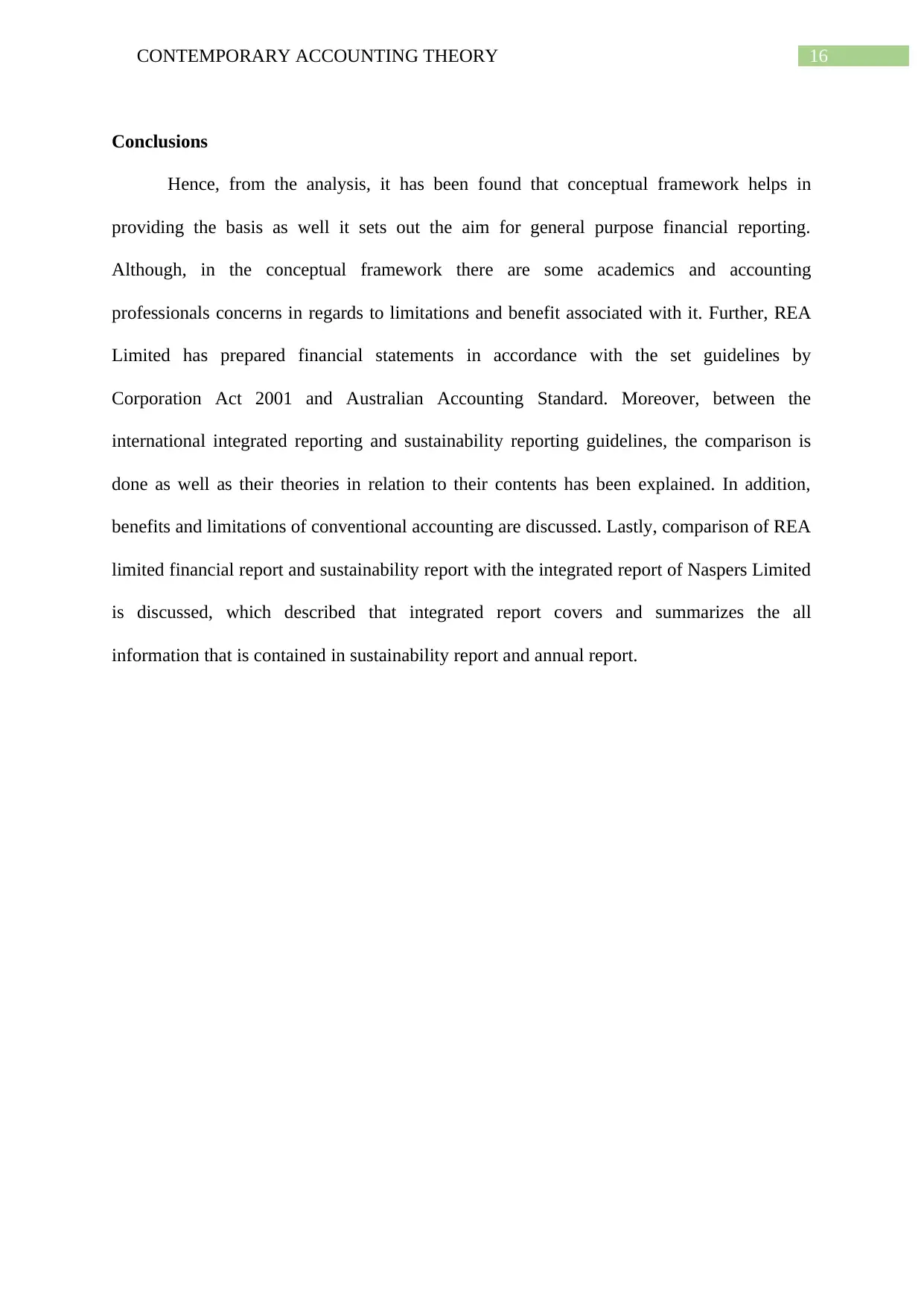
16CONTEMPORARY ACCOUNTING THEORY
Conclusions
Hence, from the analysis, it has been found that conceptual framework helps in
providing the basis as well it sets out the aim for general purpose financial reporting.
Although, in the conceptual framework there are some academics and accounting
professionals concerns in regards to limitations and benefit associated with it. Further, REA
Limited has prepared financial statements in accordance with the set guidelines by
Corporation Act 2001 and Australian Accounting Standard. Moreover, between the
international integrated reporting and sustainability reporting guidelines, the comparison is
done as well as their theories in relation to their contents has been explained. In addition,
benefits and limitations of conventional accounting are discussed. Lastly, comparison of REA
limited financial report and sustainability report with the integrated report of Naspers Limited
is discussed, which described that integrated report covers and summarizes the all
information that is contained in sustainability report and annual report.
Conclusions
Hence, from the analysis, it has been found that conceptual framework helps in
providing the basis as well it sets out the aim for general purpose financial reporting.
Although, in the conceptual framework there are some academics and accounting
professionals concerns in regards to limitations and benefit associated with it. Further, REA
Limited has prepared financial statements in accordance with the set guidelines by
Corporation Act 2001 and Australian Accounting Standard. Moreover, between the
international integrated reporting and sustainability reporting guidelines, the comparison is
done as well as their theories in relation to their contents has been explained. In addition,
benefits and limitations of conventional accounting are discussed. Lastly, comparison of REA
limited financial report and sustainability report with the integrated report of Naspers Limited
is discussed, which described that integrated report covers and summarizes the all
information that is contained in sustainability report and annual report.

17CONTEMPORARY ACCOUNTING THEORY
Reference
About | Naspers . (2019). Naspers.com. Retrieved 4 June 2019, from
https://www.naspers.com/about
Brown, J., & Dillard, J. (2015). Opening accounting to critical scrutiny: towards dialogic
accounting for policy analysis and democracy. Journal of Comparative Policy
Analysis: Research and Practice, 17(3), 247-268.
Chan, M. C., Watson, J., & Woodliff, D. (2014). Corporate governance quality and CSR
disclosures. Journal of Business Ethics, 125(1), 59-73.
Cheng, M., Green, W., Conradie, P., Konishi, N., & Romi, A. (2014). The international
integrated reporting framework: key issues and future research opportunities. Journal
of International Financial Management & Accounting, 25(1), 90-119.
del Mar Alonso‐Almeida, M., Llach, J., & Marimon, F. (2014). A closer look at the ‘Global
Reporting Initiative’sustainability reporting as a tool to implement environmental and
social policies: A worldwide sector analysis. Corporate Social Responsibility and
Environmental Management, 21(6), 318-335.
Dumay, J., Bernardi, C., Guthrie, J., & La Torre, M. (2017). Barriers to implementing the
International Integrated Reporting Framework: A contemporary academic
perspective. Meditari Accountancy Research, 25(4), 461-480.
Fernandez-Feijoo, B., Romero, S., & Ruiz, S. (2014). Commitment to corporate social
responsibility measured through global reporting initiative reporting: Factors affecting
the behavior of companies. Journal of Cleaner Production, 81, 244-254.
Ioannou, I., & Serafeim, G. (2017). The consequences of mandatory corporate sustainability
reporting. Harvard Business School research working paper, (11-100).
Reference
About | Naspers . (2019). Naspers.com. Retrieved 4 June 2019, from
https://www.naspers.com/about
Brown, J., & Dillard, J. (2015). Opening accounting to critical scrutiny: towards dialogic
accounting for policy analysis and democracy. Journal of Comparative Policy
Analysis: Research and Practice, 17(3), 247-268.
Chan, M. C., Watson, J., & Woodliff, D. (2014). Corporate governance quality and CSR
disclosures. Journal of Business Ethics, 125(1), 59-73.
Cheng, M., Green, W., Conradie, P., Konishi, N., & Romi, A. (2014). The international
integrated reporting framework: key issues and future research opportunities. Journal
of International Financial Management & Accounting, 25(1), 90-119.
del Mar Alonso‐Almeida, M., Llach, J., & Marimon, F. (2014). A closer look at the ‘Global
Reporting Initiative’sustainability reporting as a tool to implement environmental and
social policies: A worldwide sector analysis. Corporate Social Responsibility and
Environmental Management, 21(6), 318-335.
Dumay, J., Bernardi, C., Guthrie, J., & La Torre, M. (2017). Barriers to implementing the
International Integrated Reporting Framework: A contemporary academic
perspective. Meditari Accountancy Research, 25(4), 461-480.
Fernandez-Feijoo, B., Romero, S., & Ruiz, S. (2014). Commitment to corporate social
responsibility measured through global reporting initiative reporting: Factors affecting
the behavior of companies. Journal of Cleaner Production, 81, 244-254.
Ioannou, I., & Serafeim, G. (2017). The consequences of mandatory corporate sustainability
reporting. Harvard Business School research working paper, (11-100).
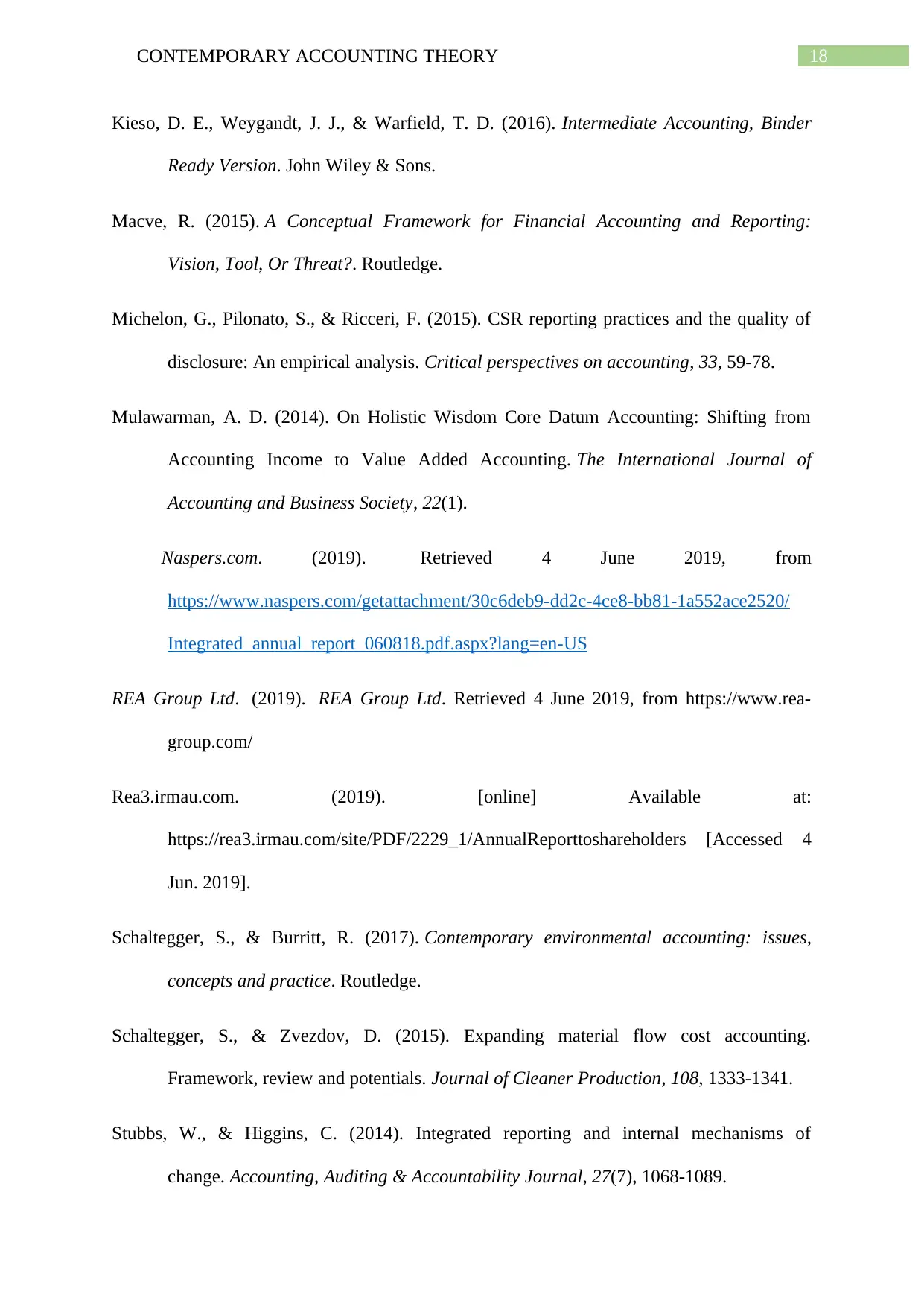
18CONTEMPORARY ACCOUNTING THEORY
Kieso, D. E., Weygandt, J. J., & Warfield, T. D. (2016). Intermediate Accounting, Binder
Ready Version. John Wiley & Sons.
Macve, R. (2015). A Conceptual Framework for Financial Accounting and Reporting:
Vision, Tool, Or Threat?. Routledge.
Michelon, G., Pilonato, S., & Ricceri, F. (2015). CSR reporting practices and the quality of
disclosure: An empirical analysis. Critical perspectives on accounting, 33, 59-78.
Mulawarman, A. D. (2014). On Holistic Wisdom Core Datum Accounting: Shifting from
Accounting Income to Value Added Accounting. The International Journal of
Accounting and Business Society, 22(1).
Naspers.com. (2019). Retrieved 4 June 2019, from
https://www.naspers.com/getattachment/30c6deb9-dd2c-4ce8-bb81-1a552ace2520/
Integrated_annual_report_060818.pdf.aspx?lang=en-US
REA Group Ltd. (2019). REA Group Ltd. Retrieved 4 June 2019, from https://www.rea-
group.com/
Rea3.irmau.com. (2019). [online] Available at:
https://rea3.irmau.com/site/PDF/2229_1/AnnualReporttoshareholders [Accessed 4
Jun. 2019].
Schaltegger, S., & Burritt, R. (2017). Contemporary environmental accounting: issues,
concepts and practice. Routledge.
Schaltegger, S., & Zvezdov, D. (2015). Expanding material flow cost accounting.
Framework, review and potentials. Journal of Cleaner Production, 108, 1333-1341.
Stubbs, W., & Higgins, C. (2014). Integrated reporting and internal mechanisms of
change. Accounting, Auditing & Accountability Journal, 27(7), 1068-1089.
Kieso, D. E., Weygandt, J. J., & Warfield, T. D. (2016). Intermediate Accounting, Binder
Ready Version. John Wiley & Sons.
Macve, R. (2015). A Conceptual Framework for Financial Accounting and Reporting:
Vision, Tool, Or Threat?. Routledge.
Michelon, G., Pilonato, S., & Ricceri, F. (2015). CSR reporting practices and the quality of
disclosure: An empirical analysis. Critical perspectives on accounting, 33, 59-78.
Mulawarman, A. D. (2014). On Holistic Wisdom Core Datum Accounting: Shifting from
Accounting Income to Value Added Accounting. The International Journal of
Accounting and Business Society, 22(1).
Naspers.com. (2019). Retrieved 4 June 2019, from
https://www.naspers.com/getattachment/30c6deb9-dd2c-4ce8-bb81-1a552ace2520/
Integrated_annual_report_060818.pdf.aspx?lang=en-US
REA Group Ltd. (2019). REA Group Ltd. Retrieved 4 June 2019, from https://www.rea-
group.com/
Rea3.irmau.com. (2019). [online] Available at:
https://rea3.irmau.com/site/PDF/2229_1/AnnualReporttoshareholders [Accessed 4
Jun. 2019].
Schaltegger, S., & Burritt, R. (2017). Contemporary environmental accounting: issues,
concepts and practice. Routledge.
Schaltegger, S., & Zvezdov, D. (2015). Expanding material flow cost accounting.
Framework, review and potentials. Journal of Cleaner Production, 108, 1333-1341.
Stubbs, W., & Higgins, C. (2014). Integrated reporting and internal mechanisms of
change. Accounting, Auditing & Accountability Journal, 27(7), 1068-1089.
Paraphrase This Document
Need a fresh take? Get an instant paraphrase of this document with our AI Paraphraser

19CONTEMPORARY ACCOUNTING THEORY
Thomson, I. (2015). ‘But does sustainability need capitalism or an integrated report’a
commentary on ‘The International Integrated Reporting Council: A story of failure’by
Flower, J. Critical Perspectives on Accounting, 27, 18-22.
Zhang, Y., & Andrew, J. (2014). Financialisation and the conceptual framework. Critical
perspectives on accounting, 25(1), 17-26.
Thomson, I. (2015). ‘But does sustainability need capitalism or an integrated report’a
commentary on ‘The International Integrated Reporting Council: A story of failure’by
Flower, J. Critical Perspectives on Accounting, 27, 18-22.
Zhang, Y., & Andrew, J. (2014). Financialisation and the conceptual framework. Critical
perspectives on accounting, 25(1), 17-26.
1 out of 20
Related Documents
Your All-in-One AI-Powered Toolkit for Academic Success.
+13062052269
info@desklib.com
Available 24*7 on WhatsApp / Email
![[object Object]](/_next/static/media/star-bottom.7253800d.svg)
Unlock your academic potential
© 2024 | Zucol Services PVT LTD | All rights reserved.





